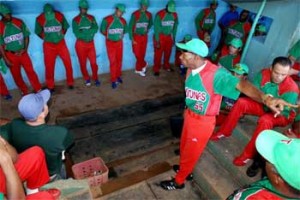Improvements in Cuban Baseball
Osmel Almaguer

HAVANA TIMES, April 18 — With a week to go before the conclusion of the regular season of the Cuban Baseball Leauge, two essential features have marked its course.
The first and most striking has been the decline in batting averages (something that in previous years was experienced in pitching), while the second feature has been the hard fought rivalries being demonstrated in each of the clashes that take place.
Regarding the decline in batting averages (more than 10 points compared to last season), I can think of four factors that have affected this to varying degrees.
The first was the exaggerated change in the height of the pitching mound (50 percent higher than the international standard). Undoubtedly those who have benefited from this are the pitchers. Of course when we talk about those who “benefited,” we’re speaking from the point of view of statistical performance.
Another thing is the real quality of our pitching, which we will again have opportunity to evaluate in upcoming international competitions.
A third step, taken early in the season (one which was much more successful, in my opinion), was the substitution of the Mizuno-150 for the Mizuno-200 baseball, which is much less lively.
In addition, the umpires were instructed to do a better job calling the strike zone (in the sense of being less restrictive), which is another benefit to the once mistreated and maligned Cuban pitchers.
Though this is a much more subjective measure, this year — after so many seasons of carping about it — they’ve finally begun to take action.
This last measure will mean a yet another net improvement for the pitchers, though it’s is a bit more difficult to prove, since it’s masked by the previous three measures.
I should reiterate that international arenas will be the stage for assessing whether there has or hasn’t been any improvement in terms of tactical thinking and versatility in Cuban pitching.
I’ll simply note that despite the overall decline in batting averages, rising star Alfredo Despaigne has just broken the record for homeruns (with 35) – and the season hasn’t even ended!
Like I already said, the second and most commendable feature of this season has been the hard fought rivalries. It’s not something that can be shown with statistics, but it’s a fact that’s verifiable through simple appreciation.
The weaker teams have been able to sweep by whoever was at the top of the standings. Those teams that seem to have escaped being caught by their closest pursuers on several occasions.
Therefore, with only six games to go, there are seven teams with no chances of making the playoffs. Nonetheless, here at the eleventh hour they’re attempting to improve their positions, though for those still in the running this could knock them out of the qualifications.
In the meantime, these other teams are not skimping on pitchers, pinch hitters or risky strategies and tactics.
Consequently, most games are ending up not only with low scores, but also with narrow margins.
With all this, Cuban baseball and the public are benefiting, and of course this begins to increase the attendance at stadiums, as often also happens at the end of the season and during the playoffs.

Actually this will be one summer when it will be hard to evaluate the status of Cuban pitching since there are no major international events scheduled until the spring of 2013. The only tournament of note this summer is the Haarlem Baseball Week, and although Cuba will send a solid team of National Series players the roster will only include players under 26 years of age. The USA Team in Haarlem will be the USA Collegiate All-Star team and not a professional team. So we will not really get a measure on Cuban pitching quality this summer.
Peter C. Bjarkman